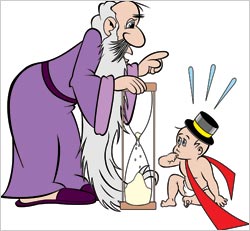 Welcome to online
advertising and marketing in 2013, where opt-in push advertising -- rather than pull -- becomes the norm, as consumers feel more comfortable allowing brands to recognize location, intent and
preferences through devices.
Welcome to online
advertising and marketing in 2013, where opt-in push advertising -- rather than pull -- becomes the norm, as consumers feel more comfortable allowing brands to recognize location, intent and
preferences through devices.
Sensors will aggregate data from siloed campaigns that feed into one analytics platform, crunching numbers and spitting out data into CRM and online ordering
systems.
Data and content will customize the Web to determine on the fly the best campaign that speaks to consumers. It all centers on personalized content with each new search query or visit
to brand Web sites or social network pages.
In 2013, the "E" in SEO transforms from engine to experience on desktop and mobile devices, as brands that purchased branded top level domain names
prepare to launch them.
advertisement
advertisement
Online advertising sits on the brink of a technological revelation. From Adobe to BlueKai to WordStream, executives weigh in to provide insight on how they think online
advertising and marketing industry media trends will evolve in 2013.
Sid Shah, director of business analytics at Adobe, believes the explosion of content will surface in the
"living room on the go" as licensing rights and better monetization capabilities enable seamless content portability for consumers. It will support the spike in mobile traffic and drive digital
advertising. By the end of 2013, one in three paid clicks could come from a tablet or smartphone.
"Cross-channel and cross-device measurement will become paramount, and the industry can
expect continued evolution of cross-channel measurement of products, reporting and analytics," Shah said.
Raj De Datta, CEO and co-founder at BloomReach, believes 2013 will
bring the death of static Web pages. Intent and browsing habits will influence the content on the page. It will change for each consumer based on intent and navigation. The data collected from that
experience will contribute to the "too much data" era. Unmanageable growth of data will force companies to autonomous machines that turn Internet data into revenue, he said. To remain competitive and
adjust to changing customer demands, businesses will enlist the help of big data applications to harness the Internet and convert sales.
Harnessing the overwhelming volume of big data will
soon reach a tipping point, proving too costly to extract value in a timely manner. Companies will face a shortage in skilled workers who are able to interpret and act on data gathered by analytic
applications. The U.S. is expected to face a shortfall by as much as 190,000 qualified data analysts by 2018. Automatic action powered by self-learning machines will replace analytics, and people will
return to what they do best: creativity, De Datta said.
Omar Tawakol, BlueKai CEO, also believes 2013 will bring cross-channel data and campaign integration from search,
video, display and mobile. "Dark corners of digital ad practices will be scrubbed," he said, and the industry will eliminate below-the-fold ad-counting practices as acceptable business practices.
By the end of the year, Tawakol said forward-thinking brand marketers will take charge of their own data and re-evaluate agencies based on their ability to drive audience insights. This critical
junction that helps to determine ROI identifies ways to gain the best use from cross-channel audience and measurement data beyond simple media performance.
Mike Baker, CEO
of DataXu, said brands began to integrate search with programmatic display advertising in 2012, as marketers capture data from paid-search traffic directly and through resellers for display
retargeting. "Perhaps more importantly, we will see more advertisers in 2013 deploying sophisticated 'omnichannel' attribution models that more accurately measure the contribution of search clicks
against the broader context of all paid, owned and earned media," he said.
Larry Kim, founder and CTO of WordStream, said 2013 will see Google "unleash additional zoo
creatures" similar to panda and penguin, two search algorithm changes. It will make SEO more complex, as well as making ads and content from Google+ more prominent in the search engine results
pages.
The shift, Kim said, will require marketers to find a stronger balance between inbound marketing strategies. The engine will become more aggressive when it comes to enforcing their
terms of service, penalizing companies with products that send automated queries, such as scraping Google SERP results to check keyword rankings. Google will delist from their index companies that
don't comply.
Angela Bandlow, VP of marketing at Extole, believes that in 2013 marketers will settle the social ROI debate because they will finally have the data to prove
strategies. With more sophisticated analytics, marketers will know those sharing stories about their brand, as well as analyze impressions, clicks, and conversions to optimize better than in the past.
Word of mouth marketing will dominate social discussion. It won't be effective to push branded marketing messages over social channels. More than 80% of purchase cycles involve WOM, so marketers will
find compelling ways to engage with their consumers to get them to spread the word. She also said paid, owned and earned media will become the rule, not the exception.
Peter
Shankman, Geek Factory founder, "hopes" 2013 will become the year marketers stop using the term "social media" when referring to a campaign. Marketers create campaigns expecting miracles
from standalone social media campaigns. Those who don't create bigger marketing, advertising, branding and communications plans designed to generate revenue will fail. He hopes marketers will stop
trying to force the "next big thing" label on every "start-up with a finished iPhone app and a half-done Android app" because it hurts the industry. "If Facebook's management plays their cards right,
they can virtually own mobile advertising" in 2013, he said.
Photo: Father Time from
Shutterstock